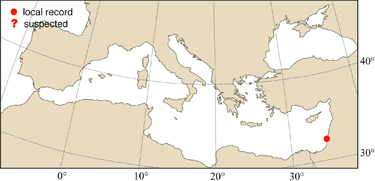
|
Relevant synonyms
Misidentification
Meristic formula
|
|
| photo : N. Lazarus |
|
SHORT
DESCRIPTION
color : body: brown to beige, with two complete or barely noticeable longitudinal dark brown stripes. The upper stripe runs from just above the eye, close to dorsal fins base, to the caudal peduncle. The lower stripe runs from the snout through the eye to the caudal peduncle. Fins transparent or light grey with grey spines and rays.
size : common 4-8 cm (max. 10 cm). |
DISTINGUISHING CHARACTERISTICS
BIOLOGY / ECOLOGY
habitat : stony or sandy substrate in marine or brackish waters to depths of 4-5 m. |
|
1st
MEDITERRANEAN RECORD
|

|
|
DISTRIBUTION
|
ESTABLISHMENT SUCCESS
speculated reasons for success : |
|
|
MODE OF
INTRODUCTION |
IMPORTANCE TO
HUMANS |
|
KEY
REFERENCES
|